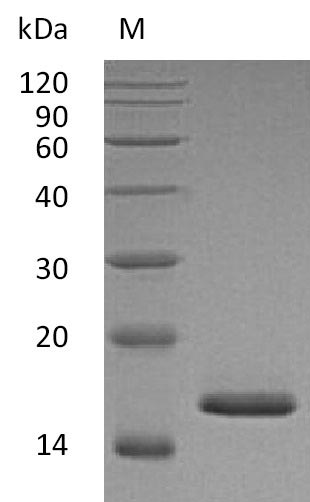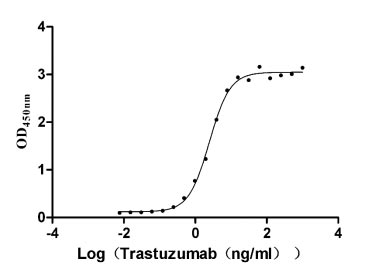Recombinant Mouse Fibroblast growth factor 1 (Fgf1) (Active)
In Stock-
货号:CSB-AP004151MO
-
规格:¥576
-
图片:
-
其他:
产品详情
-
纯度:Greater than 95% as determined by SDS-PAGE.
-
内毒素:Less than 1.0 EU/μg as determined by LAL method.
-
生物活性:The ED50 as determined by the dose-dependent stimulation of thymidine uptake by 3T3 cells in the presence of Heparin is less than 1.6 ng/mL.
-
基因名:
-
Uniprot No.:
-
别名:Fgf1; Fgf-1; Fgfa; Fibroblast growth factor 1; FGF-1; Acidic fibroblast growth factor; aFGF; Heparin-binding growth factor 1; HBGF-1
-
种属:Mus musculus (Mouse)
-
蛋白长度:Full Length of Mature Protein
-
来源:E.coli
-
分子量:15.7 kDa
-
表达区域:16-155aa
-
氨基酸序列FNLPLGNYKKPKLLYCSNGGHFLRILPDGTVDGTRDRSDQHIQLQLSAESAGEVYIKGTETGQYLAMDTEGLLYGSQTPNEECLFLERLEENHYNTYTSKKHAEKNWFVGLKKNGSCKRGPRTHYGQKAILFLPLPVSSD
-
蛋白标签:Tag-Free
-
产品提供形式:Liquid or Lyophilized powder
Note: We will preferentially ship the format that we have in stock, however, if you have any special requirement for the format, please remark your requirement when placing the order, we will prepare according to your demand. -
缓冲液:Lyophilized from a 0.2 μm filtered 20 mM Tris-HCl, 500 mM NaCl, pH 6.6
-
储存条件:Store at -20°C/-80°C upon receipt, aliquoting is necessary for mutiple use. Avoid repeated freeze-thaw cycles.
-
保质期:The shelf life is related to many factors, storage state, buffer ingredients, storage temperature and the stability of the protein itself.
Generally, the shelf life of liquid form is 6 months at -20°C/-80°C. The shelf life of lyophilized form is 12 months at -20°C/-80°C. -
货期:Basically, we can dispatch the products out in 1-3 working days after receiving your orders. Delivery time may differ from different purchasing way or location, please kindly consult your local distributors for specific delivery time.Note: All of our proteins are default shipped with normal blue ice packs, if you request to ship with dry ice, please communicate with us in advance and extra fees will be charged.
-
Datasheet & COA:Please contact us to get it.
相关产品
靶点详情
-
功能:Plays an important role in the regulation of cell survival, cell division, angiogenesis, cell differentiation and cell migration. Functions as potent mitogen in vitro. Acts as a ligand for FGFR1 and integrins. Binds to FGFR1 in the presence of heparin leading to FGFR1 dimerization and activation via sequential autophosphorylation on tyrosine residues which act as docking sites for interacting proteins, leading to the activation of several signaling cascades. Binds to integrin ITGAV:ITGB3. Its binding to integrin, subsequent ternary complex formation with integrin and FGFR1, and the recruitment of PTPN11 to the complex are essential for FGF1 signaling. Induces the phosphorylation and activation of FGFR1, FRS2, MAPK3/ERK1, MAPK1/ERK2 and AKT1. Can induce angiogenesis.
-
基因功能参考文献:
- The present results provided evidence that aFGF accelerates the progression of atherosclerosis and suggested that aFGF may be a potential therapeutic target for the prevention of atherosclerosis development. PMID: 29845277
- TUG1 knockdown ameliorates atherosclerosis by modulating FGF1 via miR-133a in ApoE knockout mice. PMID: 29268138
- Fibroblast growth factor (FGF1 and FGF2), but not vascular endothelial growth factor (VEGF) rescued Psen1-/- cells from serum starvation induced apoptosis.In the absence of serum, FGF2 immunoreactivity was distributed diffusely in cytoplasmic and nuclear vesicles of wt and Psen1-/- cells, as levels of FGF2 in nuclear and cytosolic fractions were not significantly different. PMID: 27443835
- Suboptimal FGFR activation by a weak FGF1-FGFR dimer is sufficient to evoke a metabolic response, whereas full FGFR activation by stable and sustained dimerization is required to elicit a mitogenic response. PMID: 28813681
- FGF1 protects neuroblastoma cells from p53-dependent apoptosis through an intracrine pathway regulated by FGF1 phosphorylation. PMID: 29048426
- the HDAC3-N-CoR corepressor complex leaves the Fgf1b promoter and a complex involving the translocated CRTC1, phosphorylated CREB, and histone acetyltransferase CBP induces transient transcription. PMID: 28076781
- lncRNA-Map2k4 is the target gene of miR-199a, and its down-regulation promotes miR-199a expression in neurons. miR-199a targeted regulation of FGF1 expression in neurons. PMID: 28655615
- clearly demonstrate the different specificity of FGF12-FGFR1c2 and FGF22-FGFR1c2 for well defined HS structures and suggest that it is now possible to chemoenzymatically synthesize precise HS polysaccharides that can selectively mediate growth factor signaling PMID: 28031461
- The study supports a pro-adipogenic role for betaKlotho in skeletal muscle fibro/adipogenesis and calls for further research on involvement of the FGF-FGFR-betaKlotho axis in the fibro/adipogenic infiltration associated with functional deterioration of skeletal muscle in aging and muscular dystrophy. PMID: 26881702
- fibroblast growth factor 1 (FGF1) to be synergistically induced by heat shock and wounding. PMID: 27638903
- Data suggest that Fgf1-mediated signaling represents an important signaling cascade related to adipogenesis and visceral adiposity; expression of Fgf1 (fibroblast growth factor 1) and Fgfr1 (fibroblast growth factor receptor 1) is up-regulated in adipose tissue of obese mice (both obese mice due to high-fat diet and obese mice due to genetic deletion of leptin). PMID: 26847131
- These results suggest that FGFs promote hair growth by inducing the anagen phase in resting hair follicles and might be a potential hair growth-promoting agent. PMID: 25685806
- Study presents a transcript profiling of remyelinated multiple sclerosis lesions and identified FGF1 as a promoter of remyelination PMID: 25589163
- Nucleolin-FGF1 interaction is critical for the intranuclear phosphorylation of FGF1 by PKCdelta and thereby the regulation of nuclear export of FGF1. PMID: 24595027
- parenteral delivery of a single dose of recombinant FGF1 (rFGF1) results in potent, insulin-dependent lowering of glucose levels in diabetic mice that is dose-dependent but does not lead to hypoglycaemia PMID: 25043058
- Although FGF1 transgenic mice had a normal phenotype with unperturbed kidney structure, they showed a severely inhibited kidney repair after unilateral ischemia/reperfusion. This was manifested by a strong decrease of postischemic kidney size and weight. PMID: 22606265
- RA via RALDH2 has separable functions in the developing spinal cord to (i) maintain high levels of FGF and Notch signaling and (ii) drive stem cell differentiation, thus restricting both the numbers and the pluripotent character of neural stem cells PMID: 22396766
- discovery of a phenotype for the FGF1 knockout mouse establishes the PPARgamma-FGF1 axis as critical for maintaining metabolic homeostasis and insulin sensitization PMID: 22522926
- The results demonstrate that the FGF1/FGFR1 complex constitutes a signalling module that independently of the receptor tyrosine kinase can convey a signal that initiates a strictly timed and periodic release of endocytosed FGF1 into the cytosol/nucleus. PMID: 21223966
- RFX1 may negatively regulate the self-renewal of GBM-SCs through modulating FGF-1B and FGF1 expression levels by binding the 18-bp cis-elements of the F1B promoter. PMID: 20189986
- the neuroprotective effects of FGF1 involve inactivation of GSK3beta PMID: 12095987
- FGF-1, FGF-2 and FGF receptor-1 levels in the cochlear nucleus following acoustic overstimulation PMID: 12121735
- the depletion of FGF1 may be a key regulatory component in initial phase of branching morphogenesis of the lung bud epithelium in vitro PMID: 12128203
- Agonist role for FGF1 and FGF2 in specifically insult-induced liver matrix deposition and hepatic fibrogenesis and a potential target for the prevention of hepatic fibrosis. PMID: 14507672
- non-classical release is mediated by synaptotagmin 1 PMID: 14559220
- High steady-state levels of ONOO(-) may induce cysteine oxidation, tyrosine nitration, and non-nreversible inactivation of FGF-1, a inhibitory feedback mechanism restoring cellular homeostatis during resolution of inflammation and repair. PMID: 14592461
- Gab1 is essential for FGF1 stimulation of both PI 3-kinase and the antiapoptotic protein kinase Akt, while FGF1-induced MAPK stimulation is not affected by Gab1 deficiency. PMID: 15199124
- Data show that mouse and human fibroblast growth factor 1 (FGF-1) internal ribosome entry sites show similar activity profiles, and have a conserved structural domain at both the nucleotide sequence and RNA structure levels. PMID: 15314170
- Phosphorylation of Fgf1 occurs in the nucleus by pkcdelta. It is then exported to the cytosol. PMID: 15574884
- Hsp90 is required for translocation of FGF-1 and FGF-2 across the endosomal membrane PMID: 16495214
- FGF7- and FGF1-induced mitogenesis and downstream signaling is controlled by distinct heparin octasaccharide motifs PMID: 16728399
- FGF1 and p40 synaptotagmin 1 release correlates with membrane destabilizing ability PMID: 16930531
- These results identify a novel aspect of the crosstalk between FGF and thrombin signaling pathways which both play important roles in tissue repair and angiogenesis. PMID: 17027650
- Shisa is antagonistic to Wnt and Fgf signalings PMID: 17481602
- In apoE-deficient mouse astrocytes, FGF-1 stimulated cholesterol biosynthesis without enhancing its release, indicating a signaling pathway independent of apoE biosynthesis upregulation. PMID: 17548887
- Formation of the FGF-1-exportin-1-Ran-GTP complex in vitro as well as nuclear export of FGF-1 in vivo was dependent on phosphorylation of FGF-1, and it was abolished by leptomycin B. PMID: 17616529
- sphingosine kinase 1 is a component of the copper-dependent FGF1 release pathway. PMID: 17643421
- A conserved, specific and stage-dependent requirement for Erk1/2 signalling downstream of FGF-induced neural specification in higher vertebrates. PMID: 17660197
- FGF and PDGF have roles in cell proliferation and migration in osteoblastic cells PMID: 17852407
- analysis of expression of bicistronic vector driven by the FGF-1 IRES in mouse muscle PMID: 17963525
- 6-O-sulfate in HS may regulate the signalings of some of HB-GFs, including FGF-1, FGF-2 and FGF-4, by inducing different interactions between ligands and their receptors PMID: 18281280
- and fibroblast growth factor signaling interact to control the proximal-distal pattern of forming airways in the mammalian lung PMID: 18694942
- These data demonstrate the existence of novel cross-talk between thrombin, FGF, and Notch signaling pathways, which play important roles in vascular formation and remodeling. PMID: 18784255
- An interplay between retinoic acid, Fgf and Shh signalling is likely to be an important mechanism underpinning the tight regulation of caudal embryonic development. PMID: 19168680
- A detailed double-label immunohistochemical investigation of the localization patterns of FGF1 and its receptors FGFR1 and FGFR2 in adult and early postnatal mouse retinas, is reported. PMID: 19408015
- Results revealed a mechanism of molecular coupling of mRNA transcription and translation, involving a unique process of IRES activation by a FGF1 promoter element. PMID: 19561198
- that the main role of heparin in FGF-induced signaling is to protect this naturally unstable protein against heat and/or proteolytic degradation and heparin is not essential for a direct FGF1-FGFR interaction and receptor activation PMID: 19574212
显示更多
收起更多
-
亚细胞定位:Secreted. Cytoplasm. Cytoplasm, cell cortex. Cytoplasm, cytosol. Nucleus.
-
蛋白家族:Heparin-binding growth factors family
-
数据库链接:
KEGG: mmu:14164
STRING: 10090.ENSMUSP00000045710
UniGene: Mm.241282
Most popular with customers
-
Recombinant Human Receptor tyrosine-protein kinase erbB-2 (ERBB2), partial (Active)
Express system: Mammalian cell
Species: Homo sapiens (Human)
-
Recombinant Human Poliovirus receptor (PVR) (I340M), partial (Active)
Express system: Mammalian cell
Species: Homo sapiens (Human)
-
Recombinant Human E3 ubiquitin-protein ligase ZNRF3 (ZNRF3), partial (Active)
Express system: Mammalian cell
Species: Homo sapiens (Human)
-
Express system: Mammalian cell
Species: Homo sapiens (Human)
-
Recombinant Human Alkaline phosphatase, germ cell type (ALPG) (Active)
Express system: Mammalian cell
Species: Homo sapiens (Human)
-
Recombinant Human Cell adhesion molecule 1 (CADM1), partial (Active)
Express system: Mammalian cell
Species: Homo sapiens (Human)
-
Recombinant Human CD70 antigen (CD70), partial (Active)
Express system: Mammalian cell
Species: Homo sapiens (Human)
-
Recombinant Human Gastric inhibitory polypeptide receptor(GIPR),partial (Active)
Express system: Mammalian cell
Species: Homo sapiens (Human)




-AC1.jpg)
















